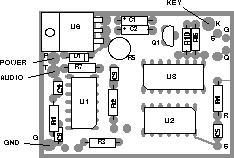
1. Connect red wire to source of unregulated or regulated power between +8 and +16Vdc @100mA.
2. Connect black wire to ground.
3. Connect white wire to audio input of transmitter.
4. Find the transmitter key line. This line is pulled to ground by the IDer during identification by saturating the open collector of a NPN transistor. The board has the capability of sinking 100mA and will accept up to 30 volts when unkeyed. If this line drives a relay, be sure it includes a diode clamp to prevent a high voltage transient which could destroy Q1.
5. The ID cycle can be started manually by shorting the pads marked "5" and "R" on the board. Use R5 to set the audio level. If the audio cannot be adjusted low enough without difficulty, add a 10M resistor in series with the white wire.
6. Attach board to convenient spot inside your equipment. The cooler the location, the better the reliability even though the IDer is designed for any temperature which is likely to exist in your equipment. In peeling the green backing, it will make eventual removal easier if only 1/4 inch of tape is exposed on each side.
ANS-2: ID will occur every 15 seconds as long as power is applied to IDer.
AUDIO FREQUENCY is controlled by R2.
CODE SPEED is controlled by R1.
CALL SIGN: Your identifier has a socket for the memory element. The memory element can be ordered from us for $10.00 and replaced in the field.
-1 to -2: Identify the jumper between the pad marked Q and the pad immediately adjacent. Cut this jumper. Add a jumper between the "Q" pad and the "G" pad which is connected to ground.
-2 to -1: Reverse the above process by cutting the jumper between "Q" and "G", and installing a jumper between the "Q" pad and its neighbor. If your board does not have the pad next to "Q", then to change to -2: connect "Q" and "G"; remove U3 and bend pin 11 straight out; replace U3 into its socket with pin 11 making no contact.